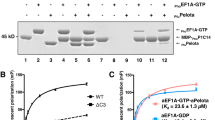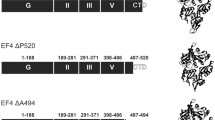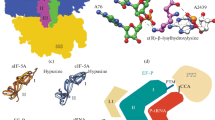Abstract
Eukaryotic elongation factor 2 (eEF2) catalyzes the translocation of peptidyl-tRNA from the A site to P site by binding to the ribosome. In this work, the complex formation of rat liver eEF2 with a synthetic oligoribonucleotide (SRD RNA) that mimics sarcin/ricin domain of rat 28S ribosomal RNA is invested in vitro. Purified eEF2 can specifically bind SRD RNA to form a stable complex. tRNA competes with SRD RNA in binding to eEF2 in a less extent. Pretreatment of eEF2 with GDP or ADP-ribosylation of eEF2 by diphtheria toxin can obviously reduce the ability of eEF2 to form the complex with the synthetic oligoribonucleotide. These results indicate that eEF2 is likely to bind directly to the sarcin/ricin domain of 28S ribosomal RNA in the process of protein synthesis.
Similar content being viewed by others
References
Bourne HR, Sanders DA, McCormick F: The GTPase superfamily: Conserved structure and molecular mechanism. Nature 349: 117–127, 1991
Sprang SR: Protein mechanisms: Insights from structure analysis. Annu Rev Biochem 66: 639–678, 1997
Nygard O, Nilsson L: Characterization of the ribosomal properties required for formation of a GTPase active complex with the eukaryotic elongation factor 2. Eur J Biochem 179: 603–608, 1989
Wilson KS, Noller HF: Molecular movement inside the translation engine. Cell 92: 337–349, 1998
Honjo T, Nishizuka Y, Hayaishi O, Katio I: Diphtheria toxin-dependent adenosine diphosphate ribosylation of aminoacyl transferase II and inhibition of protein synthesis. J Biol Chem 243: 3553–3555, 1968
Honjo T, Nishizuka Y, Kato I, Hayaishi O: Adenosine diphosphate ribosylation of aminoacyl transferase II and inhibition of protein synthesis by diphtheria toxin. J Biol Chem 246: 4251–4260, 1971
Van Ness BG, Houazd JB, Bodley JW: ADP-ribosylation of elongation factor 2 by diphtheria toxin. NMR spectra and proposed structures of ribosyl-diphthamide and its hydrolysis products. J Biol Chem 255: 10710–10716, 1980
Nygard O, Nilsson L: Reduced ribosomal binding of eukaryotic elongation factor 2 following ADP-ribosylation. Difference in binding selectivity between polyribosomes and reconstituted monoribosomes. Biochim Biophys Acta 824: 152–162, 1985
Nygard O, Nilsson L: Kinetic determination of the effects of ADP-ribosylation on the interaction of eukaryotic elongation factor 2 with ribosomes. J Biol Chem 265: 6030–6034, 1990
Wool IG, Gluck A, Endo Y: Ribotoxin recognition of ribosomal RNA and a proposal for the mechanism of translocation. Trends Biochem Sci 17: 266–269. 1992
Holmberg L, Nygard O: Interaction sites of ribosome-bound eukaryotic elongation factor 2 in 18S and 28S rRNA. Biochemistry 33: 15159–15167, 1994
Munishkin A, Wool IG: The ribosome-in-pieces: Binding of elongation factor ER-G to oligoribonucleotides that mimic the sarcin/ricin and thiostrepton domains of 23S ribosomal RNA. Proc Natl Acad Sci 94: 12280–12284, 1997
Endo Y, Chan Y, Lin A, Tsurngi K, Wool IG: The cytotoxins alphasarcin and ricin retain their specificity when tested on a synthetic oligoribonucleotide (35-mer) that mimics a region of 28S ribosomal ribonucleic acid. J Biol Chem 263: 7917–7920, 1988
Nygard O, Nilsson L: Nucleotide-mediated interactions of eukaryotic elongation factor EF-2 with ribosomes. Eur J Biochem 140: 93–96, 1984
Bradford MM: A rapid and sensitive method for quantitation of microgram quantities of protein utilizing the principle of protein-dye binding. Anal Biochem 72: 248–254, 1976
Irvin JD, Uckun FM: Pokeweed antiviral protein: Ribosome inactivation and therapeutic applications. Pharmacol Ther 55: 279–302, 1992
Henriksen O, Kobinson EA, Maxwell ES: Interaction of guanosine nucleotides with elongation factor 2. II. Effect of ribosomes and magnesium ions on guanosine diphosphate and guanosine triphosphate binding to the enzyme. J Biol Chem 250: 720–724, 1975
Nurten R, Bermek E: Interactions of elongation factor (EF-2) with guanine nucleotides and ribosomes. Binding of periodate-oxidized guanine nucleotides to EF-2. Eur J Biochem 103: 551–555, 1980
Author information
Authors and Affiliations
Corresponding author
Rights and permissions
About this article
Cite this article
Tang, S., He, Wj., Xu, H. et al. Eukaryotic elongation factor 2 can bind to the synthetic oligoribonucleotide that mimics sarcin/ricin domain of rat 28S ribosomal RNA. Mol Cell Biochem 223, 117–121 (2001). https://doi.org/10.1023/A:1017914413081
Issue Date:
DOI: https://doi.org/10.1023/A:1017914413081




